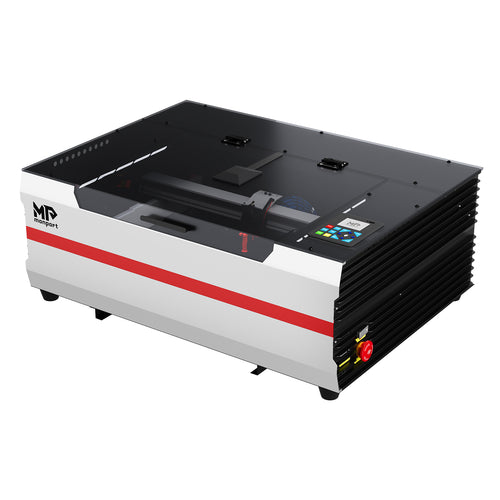A laser engraver exhaust system is essential for removing smoke, dust, and fumes produced by your laser cutter. Proper laser engraver ventilation ensures safety, protects equipment, and improves efficiency. Using a reliable exhaust fan for laser engraver or laser cutter exhaust system can prevent respiratory risks and maintain a clean workspace.
Unlock Big Savings at Monport Laser! Use code BESTMP10 at checkout for an exclusive discount – Click here to shop now!
Why a Laser Exhaust System is Important
A laser cutter exhaust system plays a critical role in four main areas:
-
Health and Safety: A laser engraver exhaust fan removes harmful gases and particles from the workspace, preventing respiratory issues and ensuring operator safety.
-
Environmental Protection: Laser engraver exhaust systems filter contaminants before releasing air outdoors, reducing pollution.
-
Equipment Longevity: Excess heat and fumes can damage laser components. A proper laser exhaust system keeps your machine clean and extends its lifespan.
-
Productivity: Clean air ensures optimal operating conditions, reducing downtime and maintaining consistent performance.

Components of a Laser Engraver Exhaust System
A laser engraver exhaust typically includes:
-
Fume Exhaust: Captures fumes at the source with a hood, blower, and filtration system.
-
Ducting: Routes exhaust gases safely to the vent, usually made from metal.
-
Exhaust Port: Releases filtered air, designed based on flow rate and type of fumes.
-
Sensors: Optional sensors monitor flow, temperature, and other exhaust parameters.
-
Control Panel: Allows operators to adjust airflow, monitor performance, and manage the system.
Planning Your Laser Cutter Exhaust
Placement Guidelines for Exhaust Fans:
-
Place the laser engraver exhaust fan near the laser cutter for maximum fume capture.
-
Ensure airflow moves contaminants away from workspaces.
-
Follow local building codes for proper installation.
-
Select the appropriate fan size based on room dimensions and laser power.
Tip: Do not rely solely on self-contained filters; exhaust laser systems are far more effective for ventilation and safety.

How to Set Up a Laser Cutter Exhaust System
-
-
Determine your laser cutter type and size.
-
Choose a location near the laser to minimize hose length.
-
Install the laser cutter exhaust fan with proper electrical connections.
-
Securely attach ducting from the laser to the exhaust system.
-
Test airflow and ensure all connections are airtight.
-
Extra Tips for Optimal Laser Engraver Ventilation
-
Location: Keep exhaust vents away from high-traffic areas to avoid hazards.
-
Ducting: Use durable, correctly sized ducts and secure them properly.
-
Filters: Choose filters suitable for your laser type and replace them regularly.
-
Maintenance: Clean vents, inspect ducts, and replace parts to ensure longevity.
-
Safety: Always wear PPE and follow regulations when using laser engraver exhaust systems.

FAQs: Laser Engraver Exhaust Systems
Q1: What’s the difference between a laser engraver exhaust fan and a regular fan?
A: A laser engraver exhaust fan is designed to remove smoke, fumes, and fine particles, whereas a regular fan only circulates air without filtration.
Q2: Can I use a self-contained filter instead of an exhaust system?
A: No. Exhaust laser systems provide superior fume removal and ventilation, which self-contained filters alone cannot achieve.
Q3: How do I choose the right size exhaust fan for my laser cutter?
A: Consider the room size, laser power, type of fumes, and ventilation requirements. Professional guidance is recommended.
Q4: Are laser engraver exhaust systems necessary for all CO2 laser machines?
A: Yes. Proper laser engraver ventilation ensures operator safety, equipment longevity, and clean working conditions.
Q5: How often should I maintain my laser cutter exhaust system?
A: Inspect and clean the system regularly, replace filters, and ensure ducting is intact to maintain performance.
Takeaways
-
Laser engraver exhaust systems protect health, equipment, and the environment.
-
Proper placement of laser cutter exhaust systems maximizes efficiency.
-
Regular maintenance ensures safety and consistent laser performance.
-
Always pair exhaust fans for laser engravers with adequate ventilation and filtration.
Conclusion
Investing in a high-quality laser engraver exhaust system is critical for any workspace using CO2 or fiber laser machines. From fume extraction to ventilation, the right laser cutter exhaust system improves safety, performance, and longevity. Ensure your workspace is equipped with a properly installed laser engraver exhaust fan and follow maintenance guidelines to protect both operators and equipment.










